One of the best ways to grab the attention of your readers is to write a striking headline. In this content-saturated climate, you’re going to want to nail it.
Catchy titles won’t only satisfy readers, they will also have a positive effect on search engines, in email, and on social media. We’ve officially entered the ‘Buzzfeed generation’ where readers won’t have the attention-span to read long, wordy titles. The best titles are snappy and often rhyme.
In fact, we recently found a campaign with 13 rhyming headlines out of 92 total headlines tested—the rhyming headlines received a 30% higher click through rate (CTR) than the non-rhyming headlines.
There’s a reason this works—there are a number of psychological reasons why we love a good rhyme.
A brief history of rhyming.
There’s strong psychological research that says rhyming in titles will actually entice readers. Our affection for rhyming is an age-old tradition that has been used in the west as far back as the medieval period and can be traced further back in the east as well.
We’re actually more likely to remember information when it’s presented in a rhyme, since it acts as a form of a mnemonic device—a technique to remember things—and there’s science behind it (Psych Central. (2016). Memory and Mnemonic Devices).
Amazingly, our brains can actually decode a rhyme more easily. Also known as “acoustic encoding”, this refers to our ability to remember and understand something learned through listening.
Rhyming in advertisements can be traced back to the 1920s with the launch of commercial radio. A few examples include “a Mars bar a day helps you work, rest and play,’’ “Winston tastes good like a cigarette should,” and “Oh thank heaven for 7-Eleven.”
Rhyming jogs our memories and is persuasive.
Rhyming can do more than just jog our memory; rhyming can also be used as a great technique to convince people of things. It’s not something we rationally understand when reading a headline, but this technique, also known as the ‘Rhyme as Reason’ effect, is known to be remarkably effective as a persuasion and sales technique.
According to researchers Filkukova & Klempe (2013) in an experiment carried out on ‘Rhyme as Reason,’ rhymes were rated by volunteers as more likeable, more original, easier to remember, more suitable for advertising campaigns, more persuasive and more trustworthy.
In another famous research paper titled, ‘Birds of a feather flock conjointly,’ researchers from Lafayette College proved that subjects found phrases more believable when they rhymed—the reason for this is that the perceived truthfulness of rhyming statements was reinforced because they sounded more fluent—and therefore were easier for the subjects’ brains to process.
So too, when we look outside the advertising world, one of the most famous phrases from the notorious OJ Simpson case was when his defense lawyer calmly stated, “If the glove doesn’t fit, you must acquit,” – and they did.
There’s more evidence to say it is extremely important for us to identify patterns in the world, and that our brains have been programmed to experience pleasure when locating a pattern. It’s no coincidence that many children’s books are written in rhyme while teaching a child to anticipate and predict the rhyming word.
Think about Dr. Seuss and the books you loved as kids – our minds are trained to predict the conclusion of the pattern and that makes us happy! This can have a powerful impact when deciding on a catchy headline for effective content marketing.
There’s no need to go overboard with rhymes, but a subtle rhyme in a slogan or a headline can enhance your content, and strengthen the credibility of your message – ultimately landing more eyeballs on your content – all without the conscious awareness on the part of the reader.

